Presidential Christmas Cards
by Bill Thornbrook
One December day it appears in the mailbox with other holiday greetings. Something sets this envelope apart, says it’s special. The return address catches the eye. Yes, just three words imprinted on a single line – THE WHITE HOUSE. Your Christmas card from the President has arrived!
Today’s Presidential holiday cards evolved during the mid-20th century from modest beginnings. Mary Evans Seeley, author of Season’s Greetings from the White House (fifth edition, 2005), traces the tradition to 1927. That year Calvin Coolidge penned a brief Christmas message to the American people on a sheet of White House stationery that was reproduced in newspapers across the nation.
Through the 1930s and 1940s, the Hoovers and Roosevelts placed orders for a few hundred “official” Christmas cards. Embellished with small black-and-white photographs and engraved good wishes, the greetings accompanied modest holiday gifts for White House employees.
Certain years might bring the mansion staff an inscribed photograph or an ornate Presidential “proclamation” celebrating the season. In 1950, for instance, the Government Printing Office prepared 1,000 colorful 9″ x 12″ broadsides on textured paper bearing the President’s message with facsimile signatures of Harry and Bess Truman (Fig. 1).
First-term Senator John F. Kennedy’s holiday card pictured his photogenic family in 1959, a year before his election as President (Fig. 2). In the White House, the Kennedys initially continued Ike’s practice of posting about 800 understated “Seasons Greetings.” But the young President soon departed from this staid format. His 1962 card showcased a charming snapshot of the mansion’s South Lawn on a wintry day as Jackie rode with one of his children in a sleigh pulled by daughter Caroline’s pony, Macaroni.
An elaborate creche display in the East Room graced the Kennedys’ 1963 Presidential Christmas card, the first to feature an overtly religious image. A portion of the Hallmark order arrived at the White House in mid-November 1963, just days before the President and First Lady went to Dallas. Prior to their departure, the Kennedys hand-signed only about 30 of the 750 cards left blank for that purpose. Those cards, together with an additional 1,600 with pre-printed signatures, were never sent. Instead, they went into storage after the President’s assassination. A few have re-surfaced since the mid-1980s (Fig. 3).
The tragedy unexpectedly thrust Lyndon B. Johnson into the Oval Office little more than a month before Christmas. The new President opted to send top government officials and foreign dignitaries a reserved white card with raised eagle seal and a thin red border as his official 1963 greeting. Prepared by Hallmark on short notice, the cards’ interiors conveyed alternate versions of a basic holiday greeting from the President and Mrs. Johnson.
Subsequent administrations abandoned these cumbersome attempts to match message to recipient. Contemporary White House cards express good cheer in phrases that may or may not actually mention Christmas. Fig . 4 samples the sentiments inside a half century’s worth of official holiday cards from Kennedy to Obama, accented with several Christmas mementos intended for Presidential friends and staff.
After more than a decade of supplying official cards, Hallmark’s exclusive White House connection was suspended for the duration of LBJ’s administration. His 1964 and 1965 cards by Robert H. Laessig, a veteran American Greetings artist, offered original perspectives of the White House in winter (Fig. 5). A southwestern willow oak in the foreground of the 1964 card (left) acknowledges the President’s Texas roots.
Since then, American Greetings has traditionally supplied the cards for Democratic administrations, as Hallmark has for the Republicans. Both businesses take pride in producing the President’s Christmas cards and have done so despite tight deadlines and financial sacrifices. Company executives coordinate closely with White House staff or even the First Lady herself to design the perfect card.
Several administrations favored historical White House views as Christmas card subjects. For instance, the 50,000 Nixon 1971 cards reproduced a 1930 N.C. Wyeth advertising poster. “Building the First White House” shows George Washington inspecting the construction site with architect James Hoban (Fig. 7).
Nixon and his two successors adopted the similar images seen in Fig. 8. At right, an 1839 print based on William H. Barlett’s painting, “The President’s House, from Washington,” was reproduced by Hallmark for Republican Richard Nixon’s 1972 card. For his final Christmas in office in 1980, Democrat Jimmy Carter sent out a then-unprecedented 120,000 American Greetings cards as a thank-you and farewell keepsake to those who had campaigned and worked for him over the years. They featured an Oval Office painting, “The President’s House,” by an anonymous artist who obviously admired Bartlett’s image (left).
For his first White House Christmas in 1974, just months after assuming office, Gerald Ford selected a comparable view (Fig. 8, center). That 1831 engraving, based on H. Brown’s bucolic scene, “The President’s House, Washington,” included vegetable gardens and a drover with sheep. Ford’s second card reproduced 35,000 copies of another rural setting far from Washington (Fig. 9). George Durrie’s c. 1825 original, a New England “Farmyard in Winter,” decorates a Green Room wall in the White House.
More recently, the First Family or White House staff sometimes directly approach a favorite independent artist. Or, several artists may be encouraged to enter an informal competition for the honor of designing the President’s card. An invitation to the White House Christmas party is the customary pay-off.
For their first Presidential card in 1981, the Reagans commissioned Jamie Wyeth , son of Andrew, grandson of N.C. His painting, “Christmas Eve at the White House,” was reproduced on 65,000 cards (Fig. 11). Returning for the Reagans’ 1984 card, “Christmas Morning at the White House,” Wyeth captured squirrel tracks in fresh snow below the North Portico.
Similarly, Bill and Hillary Clinton invited an artist they both admired, Connecticut illustrator Thomas F. McKnight, to design a series of White House Christmas cards. Beginning in 1994 with his fanciful interpretation of the Red Room, McKnight turned his attention to the Blue Room in 1995. In 1996 he rendered the Green Room in the same whimsical manner. Socks, the Presidential cat, appears in all three views (Fig. 12). By this point, American Greetings was printing 300,000 cards annually for the White House.
Two of these same rooms had already provided the themes for Ronald Reagan’s cards in 1982 and 1983 (Fig. 13). Gibson Greeting Cards was granted the opportunity to produce 65,000 copies of James Steinmeyer’s faithfully-detailed watercolor of the Red Room. Hallmark resumed its customary role the following year when asked to provide 100,000 copies of Mark Hampton’s complementary view of the Green Room. Artist Cindi Holt returned to the Red Room for George W. Bush’s 2004 card (Fig. 14).
A hint of a more somber White House Christmas marked George W. Bush’s first official card only three months after the September 11, 2001 attacks (Fig. 17). Pennsylvania artist Adrian Martinez depicted several wrapped packages left unopened beneath an eagle sconce and Mary Cassatt’s painting, “Young Mother and Two Children,” in the mansion’s private second floor corridor. This card’s message included a Biblical quote for the first time.
White House interiors appear on several other Presidential Christmas cards as well. Most have presented the more familiar public spaces–the East Room, State Dining Room, and even the Oval Office. For Barack Obama’s 2011 card, California artist Mark Matuszak focused on Presidential pooch Bo enjoying a fireplace in the cozy White House Library (Fig. 18). The entire First Family, even the dog, “signed” this card. In keeping with the times, its reverse certifies that the card was printed on recycled paper by union workers.
Mid-century Presidents sent out several tens of thousands of cards, as compared with the several hundred thousand mailed by recent administrations each year. As President, LBJ had to stick a nickel stamp on each of his greetings. This year’s Obama card carries almost ten times as much postage (49 cents). The substantial costs of designing, printing, addressing, and sending all those holiday messages are borne by the President’s political party today. After all, modern cynics perhaps justifiably consider the White House Christmas card as just one more tool in the political arsenal.


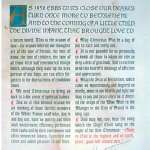
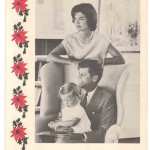
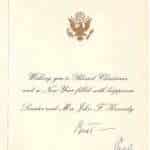

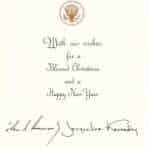
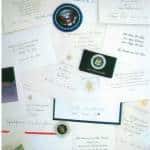
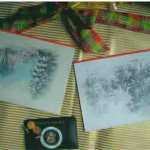
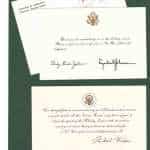
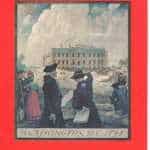

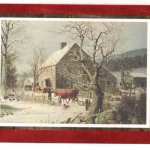
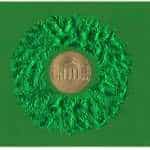


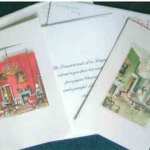
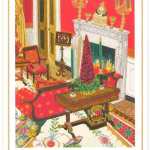

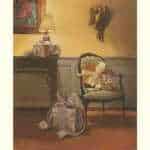
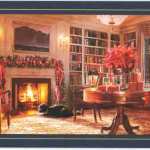




Related posts: